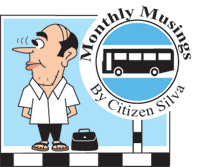Sunday Times 2
Buying dollars with rupees
View(s):February in Colombo is usually a pleasant month. The temperature is comfortable, probably preparing us for the mad heat of March. Being an old man who (unlike most of my fellow citizens) can survive this shortage of power, food and dollars without too much discomfort, I can be content today with my lot in life.
Speaking of this shortage of dollars, I was talking with a colleague, a younger journalist, who was explaining to me the serious situation in which our country finds itself because of this shortage of foreign exchange.
As we move into March 2022, Sri Lanka is woefully short of foreign currency. We are so bereft of dollars that just a few weeks ago, the Energy Minister Udaya Gammanpila (perhaps to prepare us all for an impending hike in the price of petroleum products) announced that he had been informed by the Central Bank Governor that if the Ceylon Petroleum Corporation could not deliver rupees to purchase dollars, the Central Bank will not release dollars to purchase fuel.
In the past, the rate of exchange of our rupee to the dollar was determined on the basis of what was termed a ‘managed float’. In basic terms, the demand for and the supply of dollars in the market were the principal determinants of the exchange rate–and this rate was allowed to vary depending on the supply and demand. Central Bank intervention, in the form of buying or selling limited quantities of dollars when required, tided over large fluctuations in the exchange rate.
Just under six months ago, when our Central Bank was blessed with the appointment of its new Governor, the Bank set an official exchange rate of LKR 203 per USD. This meant that all banks and authorised dealers in foreign exchange have to conform to this official exchange rate–and as a result, the banks are facing a shortage of available dollars because nobody wants to sell them dollars at this uneconomical price!
The consequence of this decision is having severe deleterious impacts on our economy. Between the new Governor and the new finance minister, our country’s finances are in dire straits–and still sinking.
We can forgive the finance minister for poor parliamentary speeches when he speaks in Sinhala (even when he reads what somebody else has written for him) and his pathetic command of spoken English when he is interviewed by TV journalists. We can even forgive him his ability to turn a serious discussion about economics to unrelated topics. This inability to grasp complicated economic concepts and the gravity of the crisis our country is facing is very worrying – even to folk like myself who do not work from air conditioned offices in the CBD.
In any country, whether it is Argentina or Zimbabwe, when the demand for dollars exceeds the supply of dollars, the official exchange rate does not allow the market to adjust itself to reflect that difference–resulting in the emergence of a black market in foreign currency.
Today I am told that those who want dollars that are not available officially (despite the fixing of an official exchange rate) are prepared to pay up to 250 rupees per dollar to buy the foreign exchange they need.
For many years our largest source of foreign currency was that earned by our migrant workers, mainly in Middle Eastern countries. While some relied on the ‘Undiyal’ (piggy banking), Fei Ch’ien or Hawala systems, many did send their earnings here via the official banks.
How the Hawala system of money transfer works is like this: Workers hand over foreign currency in the country where they work to a reliable money broker (loosely termed a Hawaldar) and the designated person in the home country is given the money in local currency at the agreed exchange rate.
This becomes attractive to folk earning money abroad to support their families in
Sri Lanka because it provides a fast and convenient transfer of funds, usually with a far lower commission than that charged by banks. Of course, the system relied on the trustworthiness of the Hawaldar.
The advantages of systems like Hawala are most pronounced when the receiving country applies unprofitable exchange rate regulations.
Prior to the Central Bank fixing the official exchange rate, most Sri Lankan workers did not resort to the Hawala system because they had bank accounts in Sri Lanka to which they transferred their foreign earnings at a realistic official rate. Today, the Hawala system is providing a realistic method for them to remit money here at a better rate than that the banks are forced to give.
The facts speak for themselves: official remittances through the banks have declined drastically–to about USD 250 million per month from around USD 500 million monthly prior to the exchange rate being fixed. It is estimated that–unless we have a more realistic official exchange rate–the adverse impact of all this will be the loss of about USD Four BILLION dollars annually.
It seems obvious (even to an octogenarian non-economist like myself–but obviously not to the finance minister and the CB governor) that this attempt to control our foreign exchange by fixing the exchange rate is just
not working.

